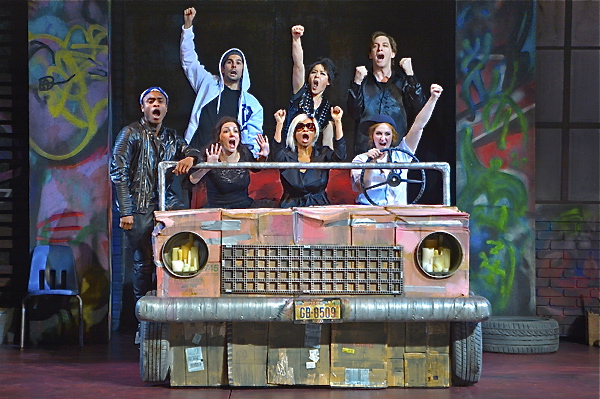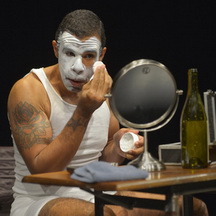“The Simpsons” meets the Apocalypse at ACT
In one scene of playwright Anne Washburn’s quirky examination of disaster and community, Mr. Burns, now at American Conservatory Theater, a man sits in a comfy chair in what seems to be his living room watching an old-fashioned tube television set, but when the set is turned around so we in the audience can see it, we discover there’s no screen, no electronics at all. The hollow plastic shell houses only flickering candles.
What’s going on? A play within a play is what’s going on. Nuclear disaster is what’s going on. Survival is going on, too, with the help of Homer and Marge and Bart and Lisa and Maggie.
Yes, the Simpsons, that surreally dysfunctional American family, are lodged deep in the hearts and minds of the play’s accidental family.
In fact The Simpsons is essential to helping them cope.
Mr. Burns is about what holds us together, and in Washburns’ view it’s shared stories. In her tale, massive nuclear power plant failures, with their resultant explosions and insidious radiation, have reduced the U.S. to roving bands of survivors. (If you’re puzzling over the play’s title, recall that Mr. Burns of the TV show is the evil, slope-browed owner of a nuclear power plant.)
In act one we meet such a roving band, five unrelated souls–Matt, Jenny, Maria, Sam, and Colleen–gathered around a wood fire in a forest, bonding over their memories of the “Cape Feare” episode of The Simpsons. Their eager recollections, meshing to get the sequence of events and the the dialogue just right, make them thrill and laugh. Millions watched the show, they watched it, too, and their happy memories of it reconnect them to a world of shared experience, a civilized world where the electrical grid hasn’t gone down.
They’re joined by another survivor, Gibson, a Simpsons fan, too. Act two transports us seven years into the future, where these six have formed a theater troupe that performs Simpsons episodes for other survivors. Electricity, and thus TV, are still missing, but the ancient Greeks and the Elizabethans did without them. They produced Oedipus and Hamlet. In Washburns’ play, post-electric America has turned to The Simpsons for a new mythology, a bonding tool, a version of the age-old tradition of tall tales by a fire.
Sounds nutty. Does the playwright make it work? I liked act one. It has spirit and laughs, and its small scale is charming. I got the idea right away, too, a take on what bonds us. Would that Mr. Burns were a one-act play. Acts two and three push too hard. They’re clever but off-putting, and the six souls we meet in act one lose their charm. They’re puppets in the playwright’s hands, not so different from the fictional Simpsons they attempt to recreate.
The direction by Mark Rucker is smart and solid, enhanced by sets by Ralph Funicello, costumes by Alex Jaeger, lighting by Alexander V. Nichols, sound by Jake Rodriguez, music by David Moschler and choreography by Amy Anders Corcoran. The actors–Nick Gabriel, Anna Ishida, Charity Jones, Jim Lichtscheidl, Kelsey Venter, Andrea Wollenberg Ryan Williams French and Tracy A. Leigh–have pep and display impressive acting/singing/dancing chops.
Mr. Burns, a Post-Electric Play holds forth on Geary Street until March 15th, followed by Maria Mileaf’s Let There Be Love and a reprise of Stephen Sondheim’s A Little Night Music. For tickets/information call 749-2250 or visit www.act-sf.org.
–ROBERT HALL
